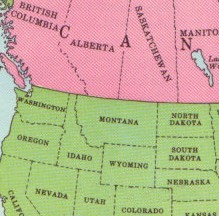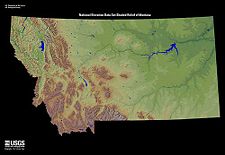Montana (U.S. state)
Montana is one of the constituent states of the United States of America. Montana has an area of 147,046 square miles (380,848 square kilometers) and a population of 1,084.225 (2020 census). It joined the Union on November 8, 1889 as the 41st state. It's capital is Helena.
Physiography
Montana straddles the Great Plains in the eastern portion of the state and the Rocky Mountains to the west. The Continental Divide runs north to south through the western Rockies. The principle rivers are the Missouri River which ultimately empties into the Gulf of Mexico and the Yellowstone River which is a tributary of the Missouri.
Climate
Overall Montana has a dry continental climate due to its isolation from the mitigating influence of any large bodies of water. Within the state, there are two main climate regions.
The eastern, or Great Plains, part of the state, the climate is semiarid with very cold winters and warm summers, occassionally punctuated by Chinook winds coming off the eastern slopes of the Rocky Mountains.
The western, Rocky Mountain portion of the state exhibits several climate zones, stratified by elevation. The dry valley bottoms are much like eastern Montana, while the Rockies become wetter, snowier, and cooler with increasing altitude.
Economy
Currently, tourism ranks as one of the most important economic activities in the state. Apart from Glacier National Park and Little Bighorn National Monument, the site of Custer's Last Stand, the state offers skiing, hiking and camping in the Rocky Mountain west and elsewhere.

